Trending
Apple Watch Series 11: Evolution, Not Revolution, But That Matters
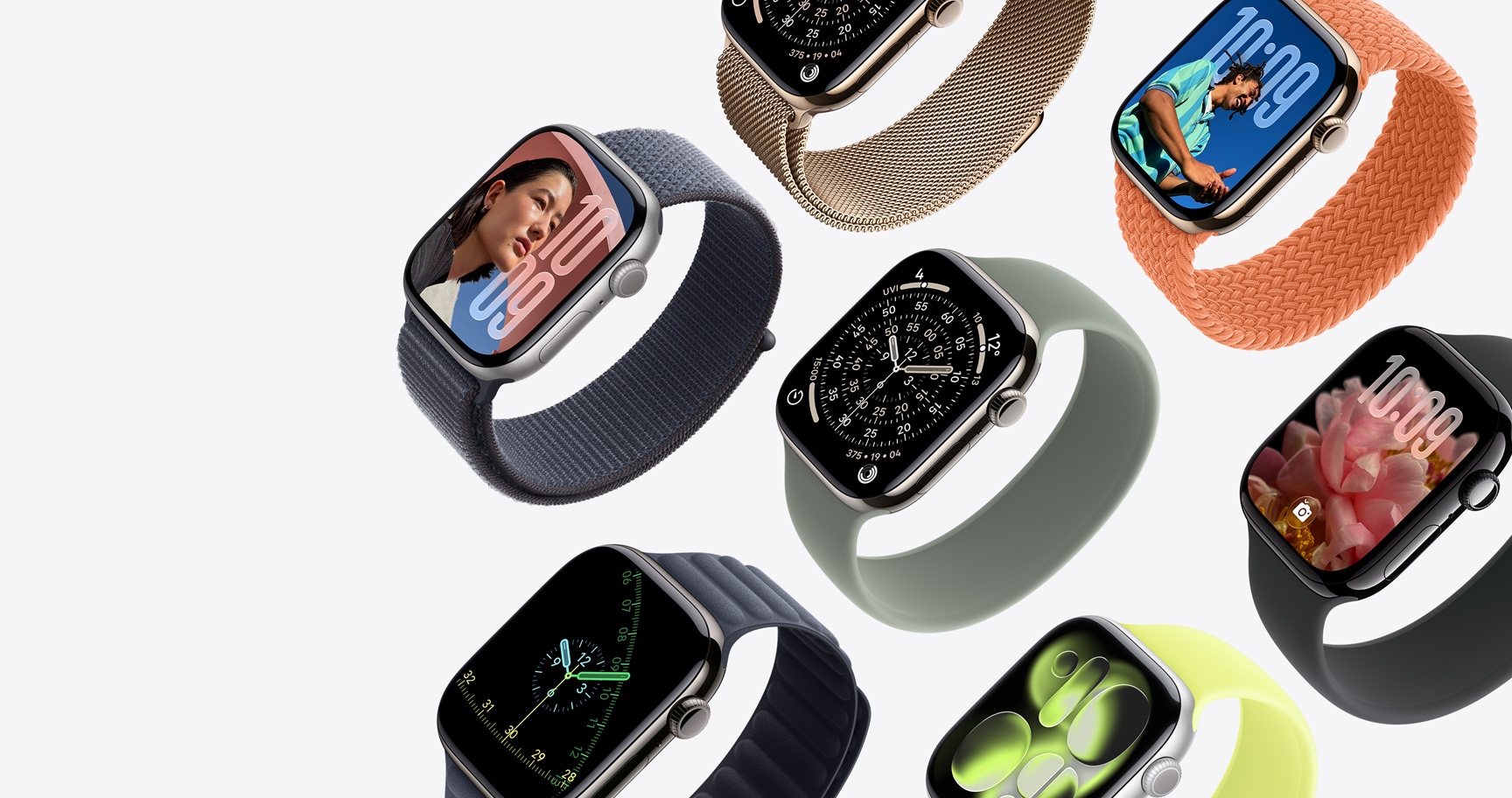
By Srijith KN, Senior Editor
The Apple Watch Series 11 feels familiar on my wrist. It upholds the design philosophy centered on continuous wearability. At a slim depth of 9.7 mm, the profile remains consistent with its immediate predecessor, the Series 10. This lightness is paramount, specifically enabling the device to be worn comfortably 24 hours a day, a requirement for capturing the overnight and long-term health metrics that define this generation.
Same rounded-square silhouette, same slim profile, same 42 mm / 46 mm dial options. But that’s not a complaint, it’s a design that works. What’s changed are the refinements under the glass and behind the scenes that has resulted in a notably improved user experience.
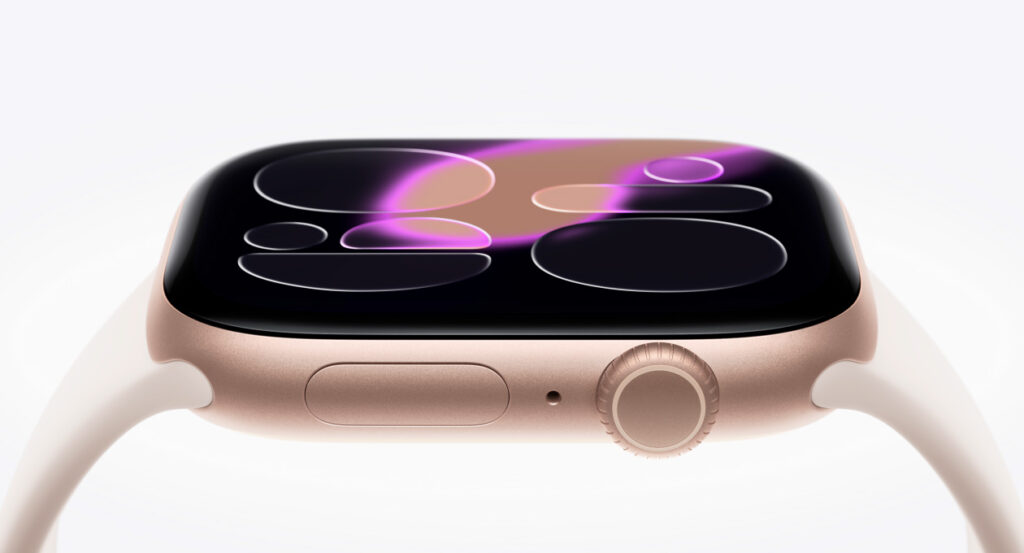
Display & Durability: Subtle But Real
The new release continues to offer a choice between aluminum and the more premium titanium cases, catering to various user preferences for weight and durability. Let me start with what might sound basic, but matters every single day: the display glass.
Apple has treated the Ion-X glass on aluminum models with a new ceramic coating that bonds at the atomic level through physical vapor deposition, making it twice as scratch-resistant as the Series 10. I know that sounds like marketing speak, but here’s why it’s genuinely significant. It’s not just tougher glass; it’s peace of mind. You stop babying your watch and actually use it.
If you opt for the titanium model, you’re getting sapphire crystal instead, the most scratch and crack-resistant material you can put on a watch display. But honestly? The Ion-X glass closes the durability gap considerably, and at a more accessible price point. The Always-On Retina LTPO3 OLED remains, but Apple has pushed it to 2,000 nits brightness, made the display borders 24 percent thinner and improved the viewing angles.
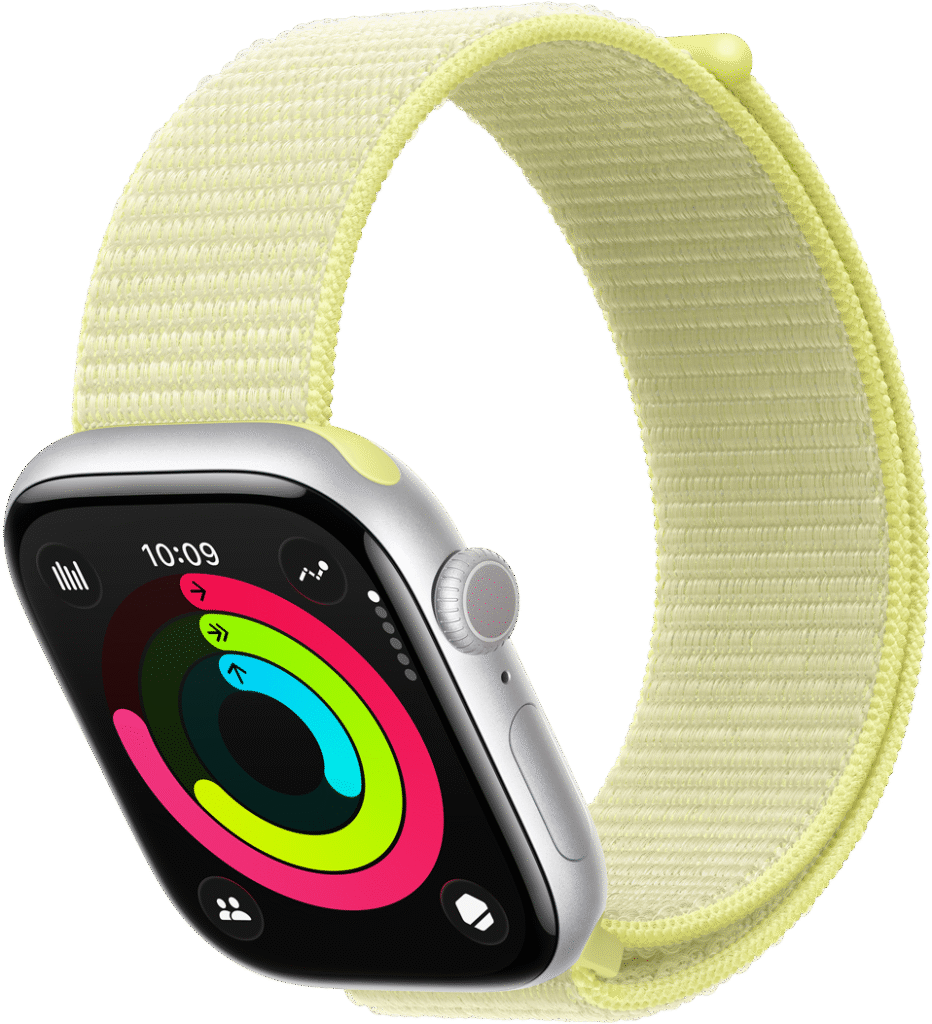
Battery Life: Official Numbers Undersell It
Here’s where Apple deserves genuine credit for listening. The Series 11 now offers up to 24 hours of battery life, a full six hours more than previous generations. My experience, however, suggests Apple’s figures are rather conservative. The larger 46 mm model routinely delivered between 40 and 43 hours of use in testing. It allowed me to get through a full day, track a full night of sleep, and still have a buffer for the next morning. And for a quick top-up, the fast-charge capability gets you to 80% in about 30 minutes, or a brief 5-minute charge provides enough juice for a night’s sleep tracking.
There’s also Low Power Mode, which stretches the battery to an official 38 hours time, which again is a very much conservative claim from Apple. I’m being realistic here, you won’t use it daily unless you’re the type who obsesses over battery percentages. But it’s genuinely useful for specific scenarios: overnight travel, a weekend hiking trip, or when you’re running late and forgot to charge overnight. You lose some fitness features and continuous health monitoring, but the core functionality remains. Although I never needed it, knowing it’s there was reassuring.
Fast charging provides eight hours of battery life in just 15 minutes, so a quick top-up while you shower is all you need. Is it multi-day for a heavy user usage? No. But 24 hours is the sweet spot where the watch becomes genuinely convenient rather than another device demanding consistent attention. And the Low Power Mode is your safety net when life gets unpredictable.
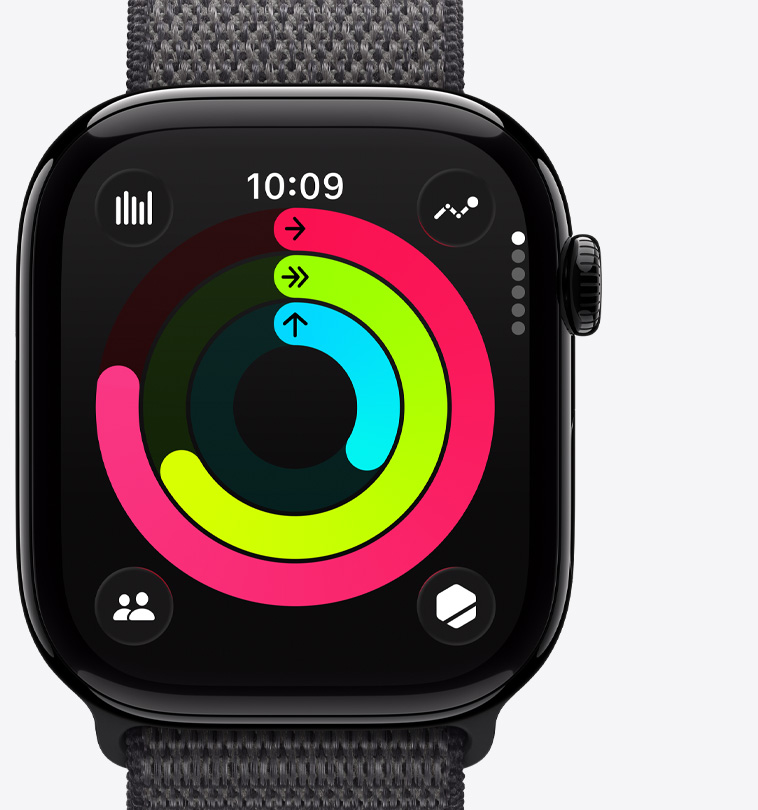
5G: More Than a Spec Bump
I was skeptical about 5G on a watch. How much data are you really downloading on your wrist? Turns out, quite a bit; and the difference is noticeable. The Series 11 features an upgraded cellular antenna covering more bands, and can simultaneously engage both system antennas when needed, significantly increasing signal strength. Translation: music streams without stuttering, and podcast episodes are downloaded in seconds instead of minutes.
The real win is reliability. The dual-antenna system on the Series 11 maintains a connection in places. I travel frequently, and this means stronger, more stable coverage, validating the Watch’s role as an indispensable safety device and a reliable lifeline when I intentionally leave my iPhone behind.

Hypertension Monitoring: A Potential Life-Saver
The Apple Watch uses its optical heart sensor to quietly track how your blood vessels respond to each heartbeat, running an algorithm in the background over 30 days to look for signs of hypertension. I haven’t been wearing it long enough for that full 30-day cycle yet, so I haven’t seen any results. But once it’s had enough data, it’s supposed to alert you if it detects patterns that might point to chronic high blood pressure — basically telling you to double-check with a proper cuff and talk to your doctor.
watchOS 26: The Liquid Glass Era
The software deserves its own recognition. watchOS 26 introduces Liquid Glass, creating a vibrant, expressive experience across the Photos watch face, Smart Stack widgets, notifications, Control Center, and navigation. It’s a visual refresh that makes the watch feel premium and modern.
Two new standout features that I found the most attractive, useful and innovative:
Wrist Flick Gesture: My number one favorite new feature. I’ve come to love the new Wrist Flick gesture. It allows me to instantly dismiss notifications or silence alarms with a quick twist of the wrist. This isn’t a clumsy accelerometer trick; the Neural Engine uses machine learning to interpret “messy motion data” , so it knows the difference between an intentional flick and me just randomly moving my arm.
Smart Stack Hints: Think of them as little nudges from your watch. The right information or app suggestion pops up just when it might be useful. The Series 11 watches your routines, movement, location, and even sensor data, then predicts what you might need before you even ask for it.
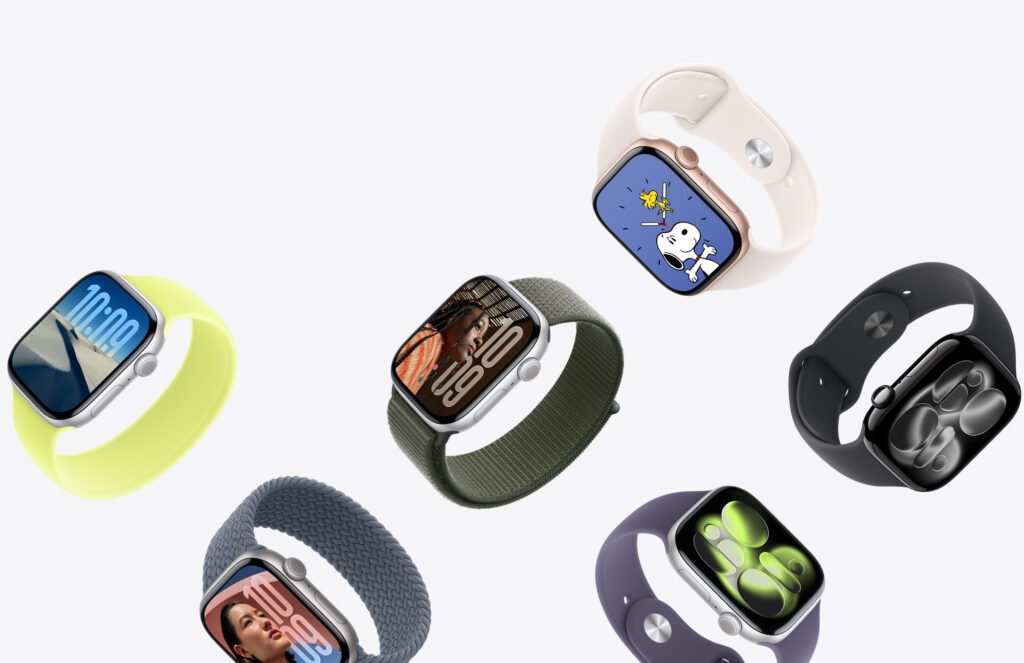
The Ecosystem Advantage: Where Apple Watch Shines Brightest
It’s in day-to-day life that the Series 11 shines. Quick glances at the wrist replace phone-checking rituals. Notifications feel natural rather than disruptive, and built-in GPS means workouts don’t tether you to your iPhone. Cycling, walking, or even scootering, the Watch feels like a personal assistant that anticipates needs without demanding attention.
Should You Buy/Upgrade?
If you own a Series 10: Probably skip it unless 5G and longer battery life address specific pain points for you. The improvements are meaningful but might seem incremental for you.
If you own a Series 6, 7, 8, or 9: This is a substantial upgrade. The display durability, battery life, 5G connectivity, and new health features justify the upgrade; especially if you’re bothered by battery anxiety or accumulated scratches.
If you’re new to Apple Watch: The Series 11 is the most refined, capable, and user-friendly version Apple has made. At 1,599 AED, (the titanium model starts at 2,799 AED) it’s a meaningful investment, that pays dividends daily if you’re already in the Apple ecosystem.
Pricing & Color Options
Aluminum – Available in Space Gray (New), Silver (New), Rose Gold and Jet Black
42 mm (GPS) – AED 1,599 46 mm (GPS) – AED 1,719
42 mm (GPS + Cellular) – AED 1,999 46 mm (GPS + Cellular) – AED 2,119
Titanium – Available in Natural, Gold and Slate
42 mm (GPS + Cellular) – AED 2,799 46 mm (GPS + Cellular) – AED 2,999
Automotive
Stage Set for World’s Largest Autonomous Race as A2RL Reaches Full Fan Capacity at Yas Marina Circuit
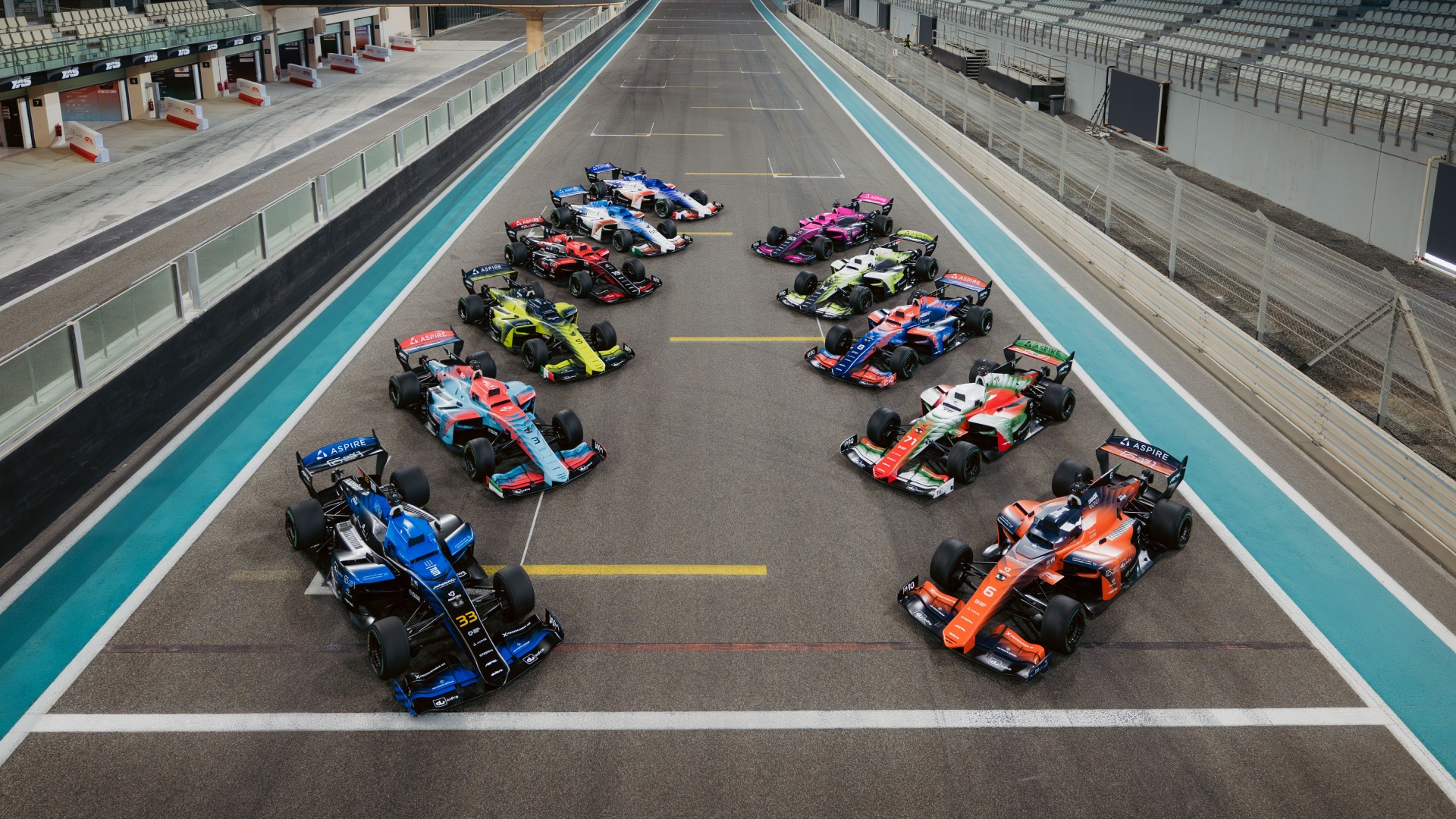
The world’s largest autonomous car race will take place in Abu Dhabi on the 15th of November, as 11 teams from across the globe compete at the frontier of robotics, autonomy and AI for a US$2.25 million prize pool. A2RL Season 2 has been 18 months in the making, with the six fastest teams making it through the tough qualification process to the Grand Final. Ticket allocation for the Yas Marina Circuit event has once again reached full capacity of the main grandstand, as motorsport and technology enthusiasts excitedly prepare to witness an AI competition unlike any other.
Grand Final: Front row seat to AI history
The A2RL Grand Final will mark the first time that six fully autonomous racecars will compete wheel-to-wheel on track. The six teams – TUM, Unimore, Kinetiz, TII Racing, PoliMOVE and Constructor – were determined by a rigorous qualification process in October. Representing Germany, Italy, and the UAE, they will compete in a 20-lap, multi-car race to crown the A2RL Season 2 Champion. Reigning Champions, TUM, have qualified in pole position after a fierce ‘Multi-Car Qualification’ sprint race against rival Unimore, setting the stage for a historic showdown.
For the remaining five teams, A2RL will host a Silver Race, offering them the opportunity to push their algorithms to the limit and cement their overall position in the standings. The Silver Race teams are RAPSON, Code 19, Fly Eagle, FR4IAV and TGM Grand Prix.

Human vs AI: Performance gap closing
Pre-season build-up for the race has seen record-setting performance as the gap between human and AI performance narrows. During qualification, Italian team Unimore was the first to beat a benchmark lap time set by a human racing driver while testing.
This demonstration of machine precision versus human instinct, and the rapid evolution of AI performance, will be showcased on race day. Reigning champion TUM will have the privilege of racing against former F1 driver Daniil Kvyat in A2RL’s second Human vs AI showcase. A close battle is expected in this exhibition, following record-breaking pace from teams during qualifying.
Supercars, Fan Zone, and more
Kicking off the evening’s main events, Group 63 will take to the track for a spectacular Supercar Parade Laps display, setting the stage for the autonomous race. This will be followed by awards for the A2RL STEM Competition, which involved 140 students from across all seven Emirates racing AWS DeepRacer 1/18th-scale autonomous cars, a mirror of the A2RL competition.
This year’s world-class Fan Zone will offer an immersive experience for all ages. It will feature humanoid robot showcases, interactive games, hands-on tech activations, live entertainment, and family-friendly attractions that will bring the excitement of autonomous innovation beyond the track.
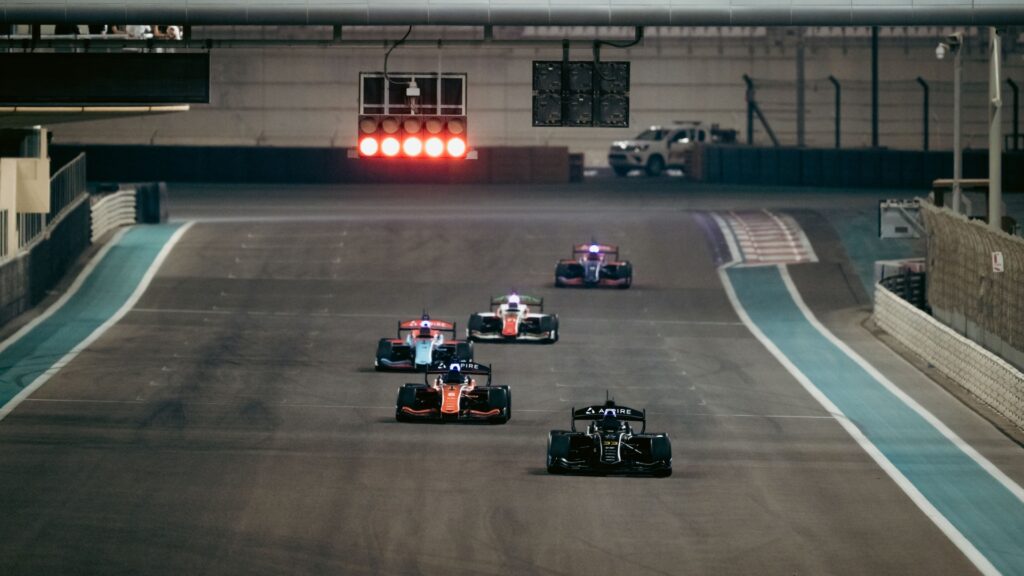
The race will be broadcast globally this Sunday, 16th November at 3pm GST, on the Abu Dhabi Media Network, StarzPlay, Motorsport TV and the official A2RL YouTube Channel. Once again, fans can step right into the action with A2RL’s live VR platform, experiencing the track, live car data, and high-speed action unfolding all around them, in real time.
A2RL is supported by SteerAI, alongside leading partner du; official partners AWS and Abu Dhabi Mobility; official supporters Wio and Castore; technical partners PACETEQ, Live in Five, Meccanica 42, and Vislink; as well as event partners Abu Dhabi Gaming, Miral and the UAE Cybersecurity Council.
Automotive
2025 NISSAN X-TRAIL FIRST DRIVE REVIEW: THE JACK OF ALL TRADES

Amalsha VS
An All-You-Need Package:
QUICK TAKE
The 2025 Nissan X-Trail is a competent midsize SUV that offers an impressively balanced blend of space, comfort, features, performance, and efficiency.
Shiny Bits
- Exceptionally feature-packed
- Excellent all-round performance
- Appreciably capable off-road
- Smooth connectivity features
Rough edges
- Cramped third row
- Limited boot space behind the third row
MODERN, AESTHETIC & CHARACTERFUL
The current-gen Nissan X-Trail takes a sharper exterior approach compared to the previous generation’s smoother, more curvaceous design language. Although not as boxy as the earlier generations, I personally think the latest X-Trail has a bit more character than its immediate predecessor. It blends in well while standing out just enough not to be an NPC-looking generic modern SUV. And the model we drove, garbed in Boulder Gray Pearl, perfectly adhered to this design philosophy.
FAST & FUN ENOUGH FOR ON-ROADING AND SOFT-ROADING

The 2025 Nissan X-Trail offers a striking combination of everything you would expect from a midsize SUV.
Looking at the X-Trail’s evolution since its inception, it has evidently transitioned into a softer version after each generation. But this time, we felt that it has travelled back to its “Tough Gear” roots, reviving a bit more of its original prowess in tackling minor sessions off the paved path. Hence, we found the new X-Trail performing admirably at whatever we threw at it, ranging from the hectic Sharjah-Dubai commute to speed bursts on some trails, although nothing like proper dune bashing in the desert.
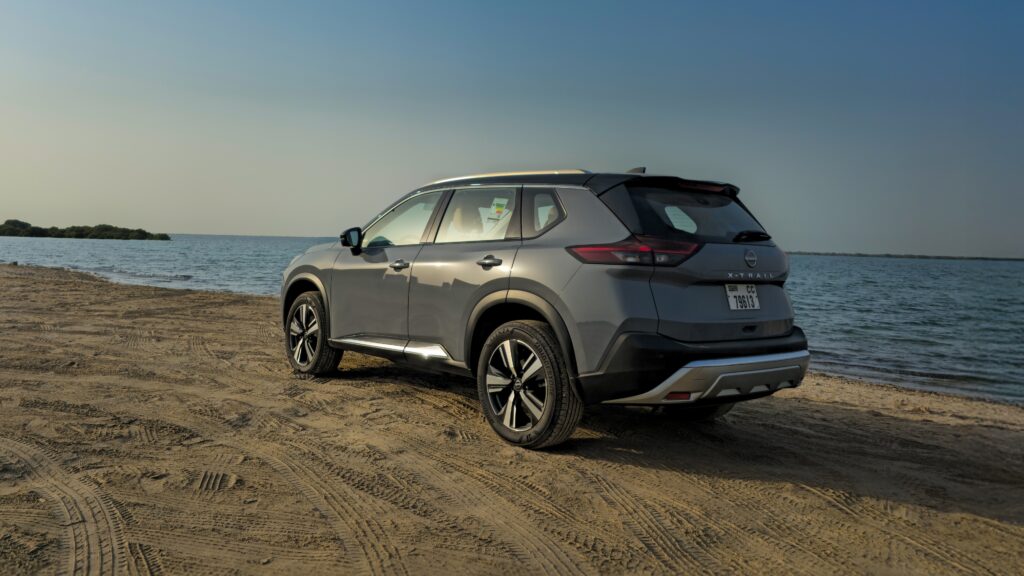
The 2025 Nissan X-Trail is powered by a 2.5-liter naturally aspirated four-cylinder motor, mated to a CVT transmission, pushing out a respectable 181 horsepower and 244 NM of torque. These figures are competent enough, and the transmission is tuned well-enough to deliver satisfying kicks without ever getting stuck in the stagnancy of the “rubber band effect” often associated with CVT transmissions. The all-wheel-drivetrain does a respectable job in delivering confident and dynamic handling on and off the tarmac. However, if you’re seeking something that can deliver decently hardcore off-roading abilities, you should consider the bigger, bolder, Nissan X-Terra.
Highway-cruising at 160 kph is effortless as a breeze, with no stability issues or crosswind scares whatsoever.
There are five drive modes to choose from, namely Auto (the equivalent of Normal/Comfort for Nissan), along with ECO, Sport, Snow and Off-Road. Auto mode redeems its identity by delivering an evidently noticeable shift in the way the X-Trail behaves under different driving conditions and styles. Efficiency is impressive in ECO mode, and still respectable in Sport mode, which unlocks the full potential of the X-Trail. 0-100 kph took just above the 8-second mark in our testing, and highway-cruising at 160 was effortless as a breeze, with no stability issues or crosswind scares whatsoever.
WELL-BUILT WITH ALL THE COMFORT AND TECH YOU’LL EVER NEED
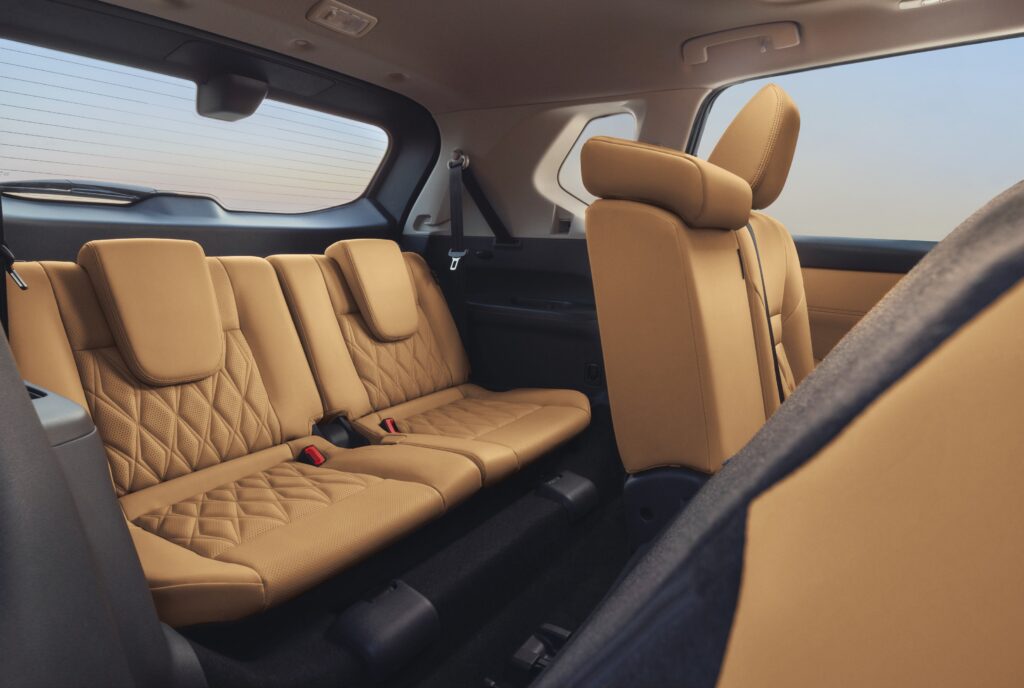
The interior of this midsize Nissan turned out to be more plush and comfy than we expected. Although there are both five-seater and seven-seater variants available, we would call it a 5+2-seater in real world conditions and recommend the third-row to be reserved for kids. The seats are well cushioned with plenty enough electrical adjustments provided, especially if you’re obsessed with finding that perfect driving posture like some of us. The second row too is decently spacious, with enough space for three adults without sacrificing headroom or legroom.
It is more than practical enough for families & luxurious enough to deliver a wow factor each time you step into it.
Another point to note is the presence of enough physical, tactile buttons. I personally consider this a blessing in today’s world where automakers tend to cram everything into a single, lifeless touchscreen screen or even worse, assign them to touch-sensitive buttons.
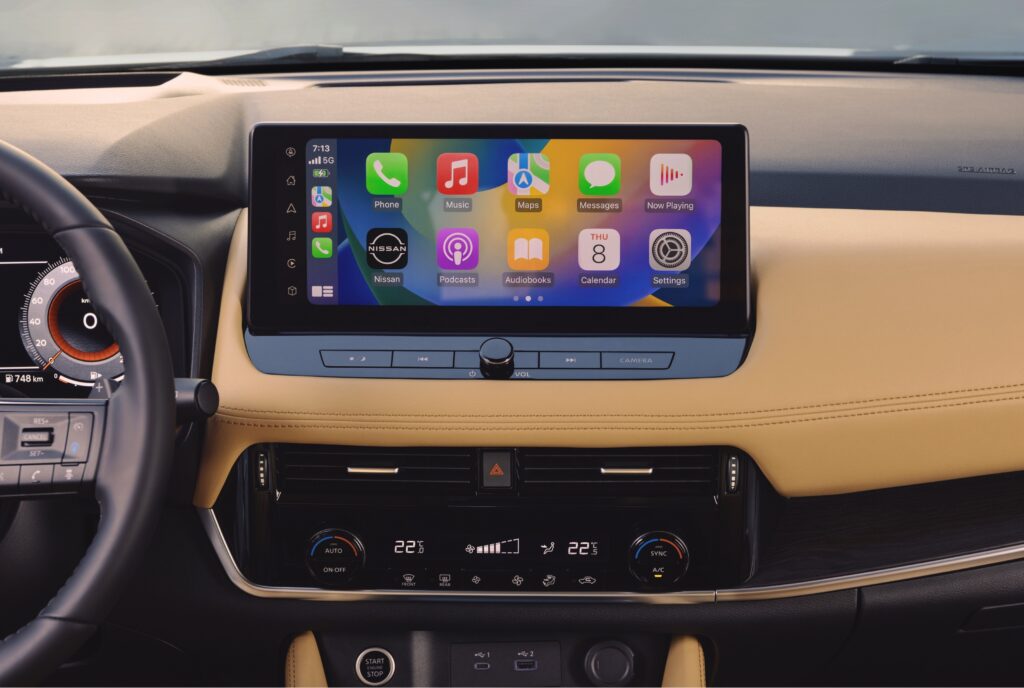
PLENTY OF TECH FEATURES
A pair of 12.3-inch screens are provided, one as the central infotainment touchscreen and the other as the instrument console. A head-up display which lets you glue your eyes onto the road and wireless charging are also features offered as standard in the top-end trims.
Among the abundantly provided tech features, we were the most impressed by the effortless wireless smartphone connectivity offered via both Android Auto & Apple CarPlay. Specifically this part which some might not consider as a pivotal aspect because we have faced issues with wireless connectivity, particularly with Android Auto in much more luxurious vehicles, some that even cost more than double the X-Trail.
Effortless wireless smartphone connectivity is offered via both Android Auto & Apple CarPlay.
Some other praiseworthy bits in the X-Trail include all the driver-assistance features you would expect in a modern car, including a rearview mirror that doubles up as a camera screen that doesn’t obstruct the view of the driver.
FINAL FIRST IMPRESSIONS
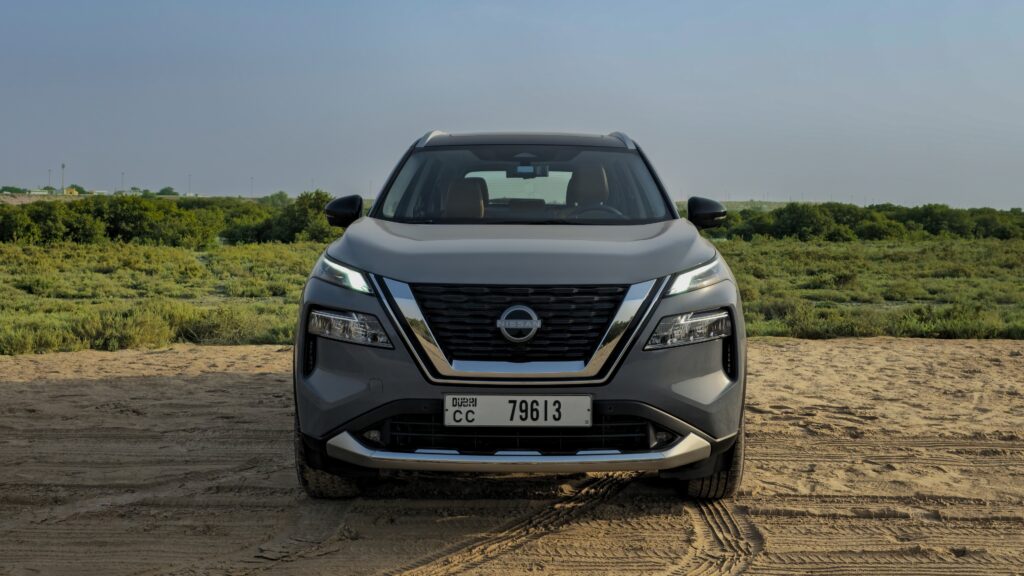
The 2025 Nissan X-Trail offers a striking combination of everything you would expect from a midsize SUV. It is more than practical enough for a family and luxurious enough to deliver a wow factor every time you step into it. From the driver’s seat it is playful and confidence-inspiring, enough to put a smile on your face whether it be on the road or on a mild trail. Overall, it is one of the most ideal machines for the region, in terms of size, segment, and performance, offering a versatile and all-inclusive personal mobility solution.
FAQ
Yes, the 2025 Nissan X-Trail is available in the UAE through authorized Nissan dealerships across the region.
The 2025 Nissan X-Trail is available in both five-seater and seven-seater configurations. The seven-seater variant functions as a 5+2-seater.
The 2025 X-Trail is powered by a 2.5-liter naturally aspirated four-cylinder engine producing 181 horsepower and 244 Nm of torque, paired with a CVT transmission.
The 2025 Nissan X-Trail accelerates from 0 to 100 km/h in just over 8 seconds.
Yes, the 2025 X-Trail features wireless connectivity for both Apple CarPlay and Android Auto, providing seamless smartphone integration.
Yes, the 2025 X-Trail is capable of soft-roading and minor off-road adventures with its all-wheel-drive system and dedicated Off-Road drive mode, though it’s not designed for hardcore dune bashing.
The X-Trail offers five drive modes: Auto, ECO, Sport, Snow, and Off-Road, allowing drivers to optimize performance for different conditions.
Automotive
Emarat unveils GCC’s first EV Service Center at ‘Al Buhaira’ station in Al Barsha
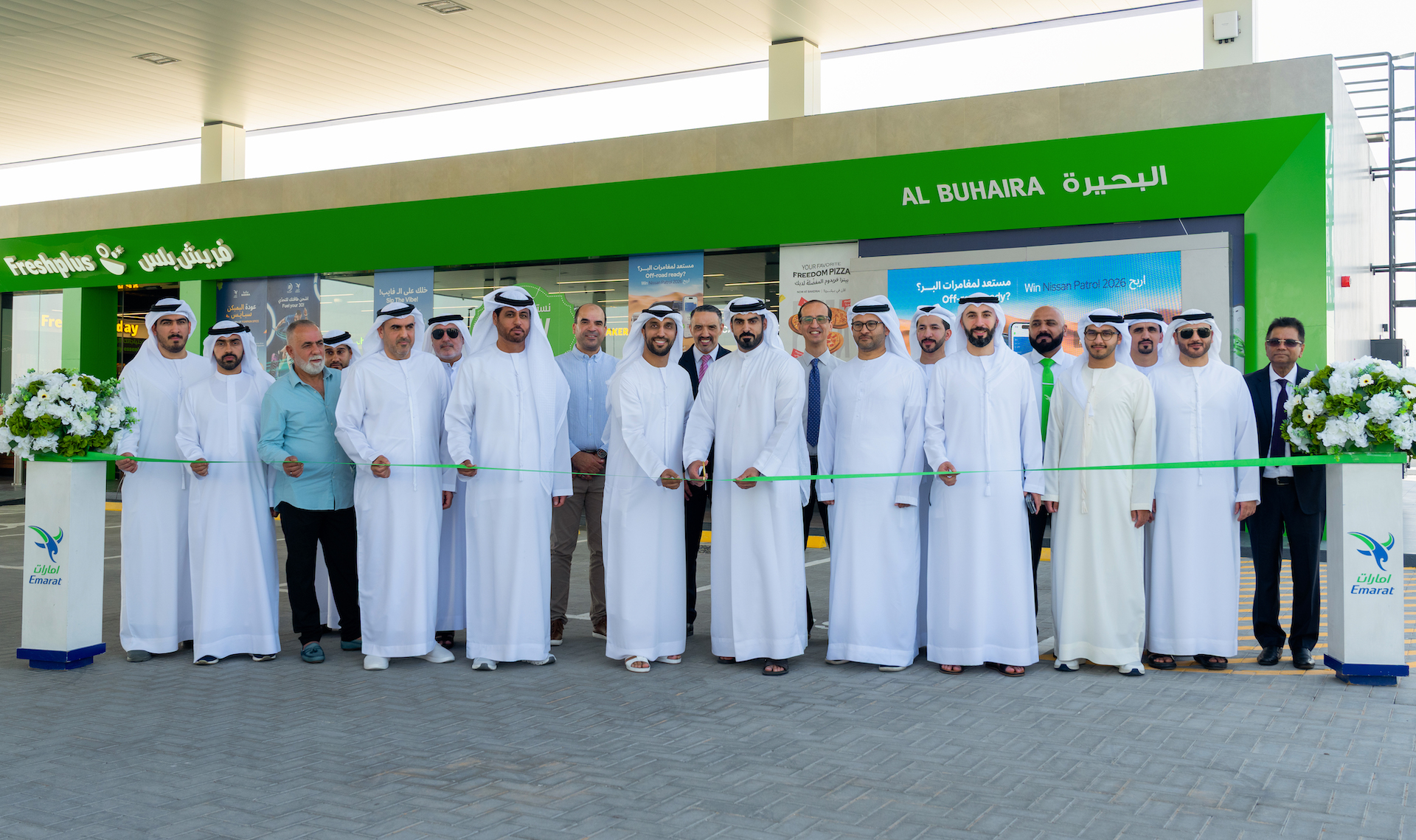
Emirates Petroleum Company PJSC (Emarat), a pioneer in the UAE’s oil and gas industry, has opened its 158th service station with the launch of “Al Buhaira” in Barsha South, expanding Emarat’s presence in New Dubai and introducing the region’s first dedicated Electric Vehicle Service Center.
The EV Service Center is being launched in collaboration with EVS – Electric Vehicle Services LLC under a Memorandum of Understanding (MoU) that aligns EVS’s expertise in EV maintenance and diagnostics with Emarat’s Lube Express network and service standards. As outlined in the MoU, the collaboration will establish co-branded “EVS Express Service Bays” within designated Lube Express facilities, with EVS managing daily operations and Emarat providing the in-station footprint, utilities and customer-flow integration; a pilot phase will run at Barsha South (Dubai), Nahrawan (Dubai) and Muwafjah (Sharjah).
Reflecting Emarat’s new brand identity, Al Buhaira station has been designed as a high-convenience destination offering motorists and nearby residents fuel, fresh food, car care and everyday retail in a single, easily accessible location. Situated on Al Barsha South Street, the station operates 24 hours to serve residents, schools, clinics, last-mile fleets and commuter traffic across New Dubai.
H.E. Ali Khalifa Al Shamsi, Chief Executive Officer of Emarat, said:“Al Buhaira marks two milestones for Emarat: a flagship addition to our New Dubai network and the GCC’s first Electric Vehicle Service Center. By partnering with EVS and integrating EV quick-service within our Lube Express model, we are extending Emarat’s promise of safety, quality and convenience to every driver—regular or electric—while supporting the UAE’s clean-mobility agenda.”
Al Buhaira station offers Special 95, Super 98, E-Plus 91 and Gas Oil, along with a Freshplus convenience store, Bakeria & Café Arabica, on-site car wash facilities, Lube Express, and a dedicated fast food offering that will open soon.
Ali Bin Zayed Al Falasi, Chief Retail Officer and Senior Vice President of Marketing at Emarat, said:
“Our vision has always been to evolve alongside our customers—anticipating their needs and redefining convenience in every journey. This site embodies that vision, blending fast access, reliable car care, and quality food and retail into one seamless experience. The new EV Service Center takes it a step further, offering future-ready diagnostics and quick service for EV owners, delivered with the same HSE excellence and efficiency our customers trust. We’re growing ever closer to our community, enhancing how they move, connect, and experience Emarat every day.”
Saeed Aljunaibi, Founder & CEO of EVS – Electric Vehicle Services LLC, said: “This collaboration with Emarat represents more than a milestone, it’s the beginning of a new era for EV ownership. EVS is building a global network that makes electric mobility effortless, combining expertise, technology, and accessibility in one ecosystem. Our goal is simple: to become the world’s most trusted name for everything related to electric vehicles, where drivers find complete solutions no one else has yet achieved.”
The station is now open to the public. Further EV quick-service rollouts under the Emarat–EVS collaboration will be announced as new locations come online.
-

 Tech News1 year ago
Tech News1 year agoDenodo Bolsters Executive Team by Hiring Christophe Culine as its Chief Revenue Officer
-

 VAR8 months ago
VAR8 months agoMicrosoft Launches New Surface Copilot+ PCs for Business
-

 Tech Interviews2 years ago
Tech Interviews2 years agoNavigating the Cybersecurity Landscape in Hybrid Work Environments
-

 Tech News4 months ago
Tech News4 months agoNothing Launches flagship Nothing Phone (3) and Headphone (1) in theme with the Iconic Museum of the Future in Dubai
-

 Tech News2 years ago
Tech News2 years agoBrighton College Abu Dhabi and Brighton College Al Ain Donate 954 IT Devices in Support of ‘Donate Your Own Device’ Campaign
-

 Editorial1 year ago
Editorial1 year agoCelebrating UAE National Day: A Legacy of Leadership and Technological Innovation
-

 VAR1 year ago
VAR1 year agoSamsung Galaxy Z Fold6 vs Google Pixel 9 Pro Fold: Clash Of The Folding Phenoms
-

 Cover Story9 months ago
Cover Story9 months agoUnifonic Leading the Future of AI-Driven Customer Engagement

























